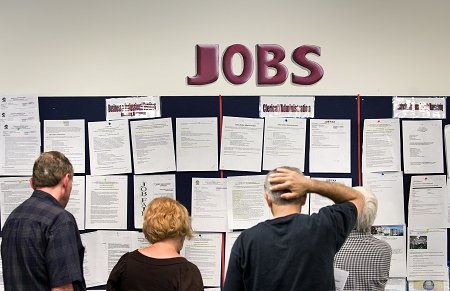 美国劳工部今早公布其月度就业形势报告,显示六月美国工作岗位新增8万个——略低于经济学家的预测,要想对目前低迷的就业市场产生积极影响,或者是想开启持久发展且有活力的经济复苏局面,就更是远远不能达标了。
美国劳工部今早公布其月度就业形势报告,显示六月美国工作岗位新增8万个——略低于经济学家的预测,要想对目前低迷的就业市场产生积极影响,或者是想开启持久发展且有活力的经济复苏局面,就更是远远不能达标了。
彭博社的经济学家预测就业岗位只会增加9万个,因为之前欧洲就业市场呈现出虚弱疲软的现状,加之制造业的显著放缓进一步给经济前景雪上加霜。
六月却也出现了少许亮点:来自一家私人工资单处理公司的报告显示,预计私人企业将新增17.6万个工作岗位,同时汽车行业的走势也很强劲,还有房地产开开始展露复苏迹象。
然而,受到欧洲和亚洲不确定性的阻挠,再加上国内高失业率和需求疲软的影响,雇主们无法大量雇佣劳动力,各种原因从而也就导致了经济复苏进程无法顺利展开。所以即使是顶尖经济学家们预测出了16.7万个新职位,也不能作为强劲信号预示经济会尽快恢复。据国会预算局透露,美国的经济发展必须每月提供至少9万个新工作岗位,才能与人口增加的速度保持平衡,要知道,9万还只是一个保守的估计数目,如果有些劳动力决定在最近重返工作岗位,那么岗位的需求量还远远不止这个数目。
那么,这份就业报告对于经济发展来说又意味着什么呢?美国经济现在显然拿不出什么好办法,就业市场从过去几个月开始一直保持着低迷的水平,但好像还没有低迷到可以让国会和联邦储蓄出手干预。再说了,随着2012大选的全面展开,如火如荼的政治活动从另一方面也暗示了,华盛顿不会兴师动众的采取什么新的经济政策了。
也有可能美联储会宣布第三轮量化宽松货币政策——所谓的QE3项目,即通过购买国债来刺激经济增长——但美联储主席伯南克一直不愿意推出这一举措。虽然六月份的就业数据很糟糕,但可能还没有糟糕到激起他的足够重视。
然而,最近一系列制造业的惨痛消息传来,于是经济学家们不得不开始猜测,可能美联储下一次会议就会宣布实施QE3项目,该会议将于7月31日-8月1日召开。加拿大皇家银行的汤姆·波切利本周告诉记者:“经济增长与通胀放缓同时发生,美联储一定会在8月1日会议上有所表示。”
这种情况下,输得最惨的人当然不是那些政客,而是那些长期处于失业困境中的540万美国民众。据国家就业法律中心资料显示,最近联邦失业救济项目和一些州项目发生的变化,将导致50万工人在8月底失去救济金。当那些政治家和官僚们在华盛顿和布鲁塞尔为了争夺丝毫的执政优势而大动干戈时,当那些首席高管们在纽约和伦敦专注于他们下一季度的收益报告时,工人们却在因为长期疏离劳动市场,而面临着技能退化的威胁。这样的情况,只会让接下来的就业报告更加暗淡,再暗淡,并将渐渐熄灭未来经济复苏的希望之光。
The Labor Department released its monthly Employment Situation Report this morning, announcing that the economy added 80,000 new jobs in June – slightly less than what economists were predicting, and far too small a number to put a dent in the unemployment rate or to be a harbinger of sustained and vigorous economic recovery.
Economists surveyed by Bloomberg news were expecting 90,000 new jobs added, after weak numbers in Europe and a pronounced slowdown in manufacturing activity further dampened prospects for the economy.
There were a few bright spots in June: a report from the private payroll processing company ADP predicted that the private sector would add 176,000 new jobs, while auto sales were strong and indications of a nascent housing recovery were present.
But it appears that the headwinds of uncertainty in Europe and Asia, paired with high unemployment and weak demand at home, are preventing employers from undertaking the kind of hiring that could induce an economic comeback. Even the high end of economists’ expectations – 167,000 new jobs — wouldn’t have represented a robust-enough number to indicate a swift or sustained recovery. According to the Congressional Budget Office, The U.S. economy must to add at least 90,000 jobs a month to keep up with population growth, although that number is an estimate and could range higher depending on how many workers decide to rejoin the labor force in a given month.
So what does this jobs report mean for the economy going forward? The U.S. economy can apparently do no better than tread water. The employment numbers of the past few months have been pretty dim, but not dim enough to spur action from Congress or the Federal Reserve. And with the 2012 Presidential election in full swing, political realities virtually guarantee that there will be no new fiscal policy initiatives out of Washington.
There is a chance that the Federal Reserve will announce a third round of quantitative easing — a so-called QE3 program of bond buying in an attempt to stimulate the economy — but Fed Chairman Ben Bernanke has been reluctant to launch such an initiative. And while June’s jobs numbers are bad, they may not be dismal enough to whet the his appetite now.
However, recent poor manufacturing data led some economists to speculate that QE3 could be announced as soon as the Fed’s next meeting, which runs from July 31 to Aug. 1. As Tom Porcelli at RBC Capital Markets told Reuters this week:“With both the growth and inflation components slowing sharply, this puts the Fed firmly in play at the August 1 meeting.”
Of course the real losers in this situation aren’t the politicians, but the more than 5.4 million Americans among the long-term unemployed. According to the National Employment Law Center, recent changes to the federal unemployment benefits program and the expiration of some state programs will cause half a million of these workers to lose their benefits by the end of August. While politicians and bureaucrats in Washington and Brussels fight a trench war for the slightest political advantage, and while C-suite executives in New York and London focus on their next quarterly earnings report, workers’ skills steadily erode as they become more alienated from the labor market. That’s a problem that will only make the next few jobs reports bleaker, not better, and push any hope for real recovery further into the future.
 美国劳工部今早公布其月度就业形势报告,显示六月美国工作岗位新增8万个——略低于经济学家的预测,要想对目前低迷的就业市场产生积极影响,或者是想开启持久发展且有活力的经济复苏局面,就更是远远不能达标了。
美国劳工部今早公布其月度就业形势报告,显示六月美国工作岗位新增8万个——略低于经济学家的预测,要想对目前低迷的就业市场产生积极影响,或者是想开启持久发展且有活力的经济复苏局面,就更是远远不能达标了。
